China’s Wau Shan Mountain
We traveled from the old city of Xi-an to small Huashan Village, at the base of 7,200 foot high Hua Shan (shan means mountain).
(Click on the Pictures for Large Format)
The mountain is a Chinese national park and a sacred Taoist site where many aspirants, according to tradition, have became immortals though their practice of the Way upon it. The most notable is Cheng Yuan, who would sleep for years on end, and presumably entered the higher worlds in his sleep state. There is an enormous relining statue of him in bronze at the base of the mountain, asleep of course. It’s hard to estimate how much the bronze alone in that statue might have cost, but the Chinese seem to have endless resources for their public projects.
This mountain is enormous. The agricultural plains rest at its feet at about 1200 feet elevation. Wau Shan towers nearly straight up from them to nearly 7500 feet. Yesterday in Huashan Village we walked through the Jade Spring Temple and up the mountain stream that descends from Hua Shan. The clean granite cliffs and remarkably vertical topography can’t help but bring Yosemite to mind, and the sense of quiet and rest was tangible as the clear water played down the tumbled boulders. I waded and drank from the stream.
This morning we boarded a bus that wound up a stunning road amidst granite cliffs and beautiful pines all around and the views becoming increasingly breathtaking as we rose in elevation. Austrian made cable cars (reassuring), elevated us at a very steep angle up through the precipitous canyons as the views became almost unbelievably grand. Many cliffs are well over a thousand feet straight or nearly straight down and one appeared to tower three thousand feet above us.
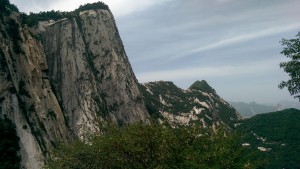 I mentioned this is a Chinese national park. It is also a pilgrimage site with over a thousand years of tradition associated with it. Many Chinese travel from far away provinces to make the very demanding 6 1/2 mile ascent on foot from the valley floor to the top. Many set out at midnight, or at five in the morning and climb steeply between 7 and 12 hours along a flowing stream and then up the canyons and then up an endless series of granite stairs, constructed over many centuries, often simply cut into the stone cliffs, often so steeply that one has to hold onto chains to keep from falling off. Less devoted or fit pilgrims take the old cable car to north peak, and then walk the “spine” of Hua Shan rising steeply about 3000 feet in elevation before gaining the summit. This can be done in three to six hours depending on one’s condition, and providing one doesn’t give up or die along the way.
I mentioned this is a Chinese national park. It is also a pilgrimage site with over a thousand years of tradition associated with it. Many Chinese travel from far away provinces to make the very demanding 6 1/2 mile ascent on foot from the valley floor to the top. Many set out at midnight, or at five in the morning and climb steeply between 7 and 12 hours along a flowing stream and then up the canyons and then up an endless series of granite stairs, constructed over many centuries, often simply cut into the stone cliffs, often so steeply that one has to hold onto chains to keep from falling off. Less devoted or fit pilgrims take the old cable car to north peak, and then walk the “spine” of Hua Shan rising steeply about 3000 feet in elevation before gaining the summit. This can be done in three to six hours depending on one’s condition, and providing one doesn’t give up or die along the way.
Some of our group actually walked the entire route from below. Most of us older or infirmer folks made the shorter pilgrimage. I’ve had a fairly serious respiratory condition for two weeks now that prevented a heroic effort and forced me to walk slowly and meditatively the three thousand feet of stairs and steep trail. I won’t ever forget that walk. It was difficult and indescribable. The chains along the pathways are thickly bedecked in many places with tens of thousands of inscribed padlocks and countless red strips of cloth with prayers printed on them. The locks seal in the pilgrims’ intentions. The prayers express the serious intent of the Taoist seekers.
our group actually walked the entire route from below. Most of us older or infirmer folks made the shorter pilgrimage. I’ve had a fairly serious respiratory condition for two weeks now that prevented a heroic effort and forced me to walk slowly and meditatively the three thousand feet of stairs and steep trail. I won’t ever forget that walk. It was difficult and indescribable. The chains along the pathways are thickly bedecked in many places with tens of thousands of inscribed padlocks and countless red strips of cloth with prayers printed on them. The locks seal in the pilgrims’ intentions. The prayers express the serious intent of the Taoist seekers.
T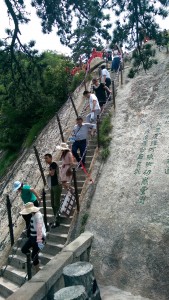 he way is often up very, very steep stone steps cut in the granite itself. One holds to the chains to help with stability. Astoundingly, porters, sometimes young men, but often older men, carry heavy loads of goods, foodstuffs, water bottles and souvenirs, up the mountain to dozens of trail side cafes, and bundles of garbage down it. Everything to serve the thousands of pilgrims and tourists who make this ascent daily must be carried in. Some of the porters augment their wages by singing traditional Chinese folk songs as they walk or when they stop to rest, for which yuan notes are placed before them. Some of the voices are truly beautiful. They choose pullouts with dramatic views to stand and sing and they are hugely picturesque with their long stick bundled on both ends and borne on the shoulder. One tossed the long load-bearing stick from one shoulder to another, ducking deftly beneath it in rhythm as he sang. One played the harmonica as he ascended. Talk about breath control! Another a flute. Another, at least 70, actually smoked a cigarette as he walked with his load up the steep steps. Astounding.
he way is often up very, very steep stone steps cut in the granite itself. One holds to the chains to help with stability. Astoundingly, porters, sometimes young men, but often older men, carry heavy loads of goods, foodstuffs, water bottles and souvenirs, up the mountain to dozens of trail side cafes, and bundles of garbage down it. Everything to serve the thousands of pilgrims and tourists who make this ascent daily must be carried in. Some of the porters augment their wages by singing traditional Chinese folk songs as they walk or when they stop to rest, for which yuan notes are placed before them. Some of the voices are truly beautiful. They choose pullouts with dramatic views to stand and sing and they are hugely picturesque with their long stick bundled on both ends and borne on the shoulder. One tossed the long load-bearing stick from one shoulder to another, ducking deftly beneath it in rhythm as he sang. One played the harmonica as he ascended. Talk about breath control! Another a flute. Another, at least 70, actually smoked a cigarette as he walked with his load up the steep steps. Astounding.
It seems to be a long tradition that as you walk, you express your devotion and aspiration and intentions to the mountain, which is considered a living being, in long single shouts, so the air is punctuated regularly by much shouting. I suspect it is the younger men who do most of the shouting, but I hear female voices, too. The voices reverberate for many seconds off the cliffs. This shouting goes on all day and all night as well.
China is a grandly populous country, and this being the pilgrimage site it is and of such beauty, I guess it is not surprising that the wide stone and concrete trails are thick with people from bottom to top. The only escape is early in the morning. Chinese are very sociable and verbal, and often speak loudly, so the air is constantly full of their exuberant conversation. Mountain silence and peace doesn’t seem to be a concept.
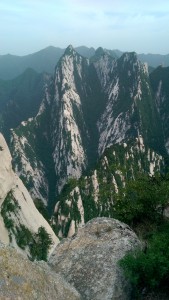 This morning I went out early to walk the quiet trails before the new arrivals reached the heights and photographed the wonderful trees and plants and the many signs marking them. I’ve been surprised to find big blooming lilac bushes in profusion, two species of maples, a beautiful red papery-barked birch, oaks, spruce, elderberry, smoke tree, solomon seal and dozen other shrubs I recognize growing wild on the slopes here. It’s exciting to see whole new species of plant families I’ve known for decades.
This morning I went out early to walk the quiet trails before the new arrivals reached the heights and photographed the wonderful trees and plants and the many signs marking them. I’ve been surprised to find big blooming lilac bushes in profusion, two species of maples, a beautiful red papery-barked birch, oaks, spruce, elderberry, smoke tree, solomon seal and dozen other shrubs I recognize growing wild on the slopes here. It’s exciting to see whole new species of plant families I’ve known for decades.
Yesterday, in the evening we all walked about thirty minutes to the top of south peak where the chains along the brink were laden thick with red prayer bands, then descended a bit before leaving the main trial to nose into the brush and scurry along the edge of the cliffs until we came to a wondrous spot at the edge of a 3000 foot cliff. We looked across the immense valley/canyon to a mountain that rose up powerfully but gracefully nearly as high as we were giving an overwhelming sense of enormity to the landscape. Large rounded granite faces that surrounded us were all deeply carved with Chinese characters, certainly ancient Taoist texts or poems. I wish I could have read them. Here, looking out at this view, we practiced Qi Gung gathering the earth energies and the heaven energies, and it was indeed a profound experience. I sat for an hour afterwards in the wind trying to take it all in, and taking some photographs in a frail attempt to capture a fraction of the grandeur of the place.
Today I learned that several hundred feet below where we sat they have built a plank walk out over the sheer cliff for the thrill seekers who pay and are strapped in to safety before walking out along the sheer face. I’m content to sit atop the rounded promontaries gazing out at the spectacular scenery. Immense peaks sweep up across huge canyons. Range on range of grand jagged mountains recede into the distance.
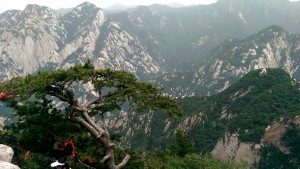 It is said that one can leave one’s past here on Hua Shan, that the mountain has the power to give you a new life. Many people on our trip have told me that all my coughing and coughing is certainly a purification process, of letting go of old “congestion.” I would like to believe that. I have noticed with friends in the past that serious illnesses have often marked turning point in their lives. This one comes close to being considered serious; it has been a great weight upon me the entire trip. Just when I think I am better it simply finds a new place in my body to invade and alarm. I hope I’m being purified from top to bottom. Whatever the case, these mountains and sacred sites and immense, powerful works of art have made a deep impression on me and I go away changed.
It is said that one can leave one’s past here on Hua Shan, that the mountain has the power to give you a new life. Many people on our trip have told me that all my coughing and coughing is certainly a purification process, of letting go of old “congestion.” I would like to believe that. I have noticed with friends in the past that serious illnesses have often marked turning point in their lives. This one comes close to being considered serious; it has been a great weight upon me the entire trip. Just when I think I am better it simply finds a new place in my body to invade and alarm. I hope I’m being purified from top to bottom. Whatever the case, these mountains and sacred sites and immense, powerful works of art have made a deep impression on me and I go away changed.
Read the Poem of the Week: The Size of Mountains
Read more about Words of the Land
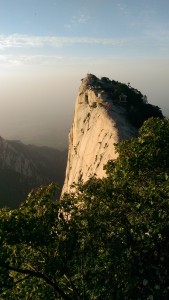
Ni Hao Garth,
Tom Weaver, Two Spirited Sycamore Tree here in Minnesota. Wonderful images and thoughts regarding your pilgrimage to the Taoist Shan near Xi’an. The purification of the body and how the tension and congestion moves around now and again. I remember meeting you fresh off the ferry from San Francisco and your taking my to the home of one of my Glessner relatives who had lived in Mill Valley, and we walked and chatted among the plant and tree people around Muir Woods. Thanks for your gentle and inspiring words. May you walk in balance. Peace, love, joy and beauty each day. Mitakuye Oyasin (D/Lakota) We are all related.
Ah, the mountains of China! It is an amazing country, but yes, mountain peace and silence are hard to come by in a country with 4 times as many people as the USA. We go to a farmer guesthouse in Zhejiang where the mountains may not be so high or dramatic, yet are much more peaceful. You must come with us sometime.
I understand the wish for purification, yet I am constantly reminded that life itself is not so pure. Water that is too pure does not sustain life as well, and with a little dirt in it cleans windows much better. A gut with no bacteria cannot digest our food. A little dirt makes life rich…and much more interesting. We will talk about that this summer.
Hope you are feeling much better.
See you later in the week. Loved the mountain climb and the words! Purification is our path this year.
Purification is the name of the work these days…I’ve been at it for the whole last year! See you this week. blessings, jo
Took my breath away Garth! I especially liked the image of the singer and all the red cloths and padlocks. It’s like he is a conduit for all those prayers and intentions left by pilgrims – so many of them. Stunning! Wow! What an adventure.
Thank you for sharing!
Wow! Thanks so much for your lovely writing and photos! wish I had known that you were sick and could have shipped you a bag of Superfruit C. Glad you’re all better. Thanks for your phone call and beautiful message. let’s catch up soon.
Thanks Garth! Great to read again and to see photos. That last photo is breathtaking. I meant to tell you that your last wordsoftheland contribution written I believe on the airplane over to China was one of the best I’ve read. I really enjoyed it. : ) Thank you.
Thanks!
Wow! Thanks for sharing your journey with us. Remarkable. I hope your cough is better now.
All better, thanks. Just trying to integrate that outrageous experience. Challenging to go back to the work-a-day world, and perhaps I won’t!